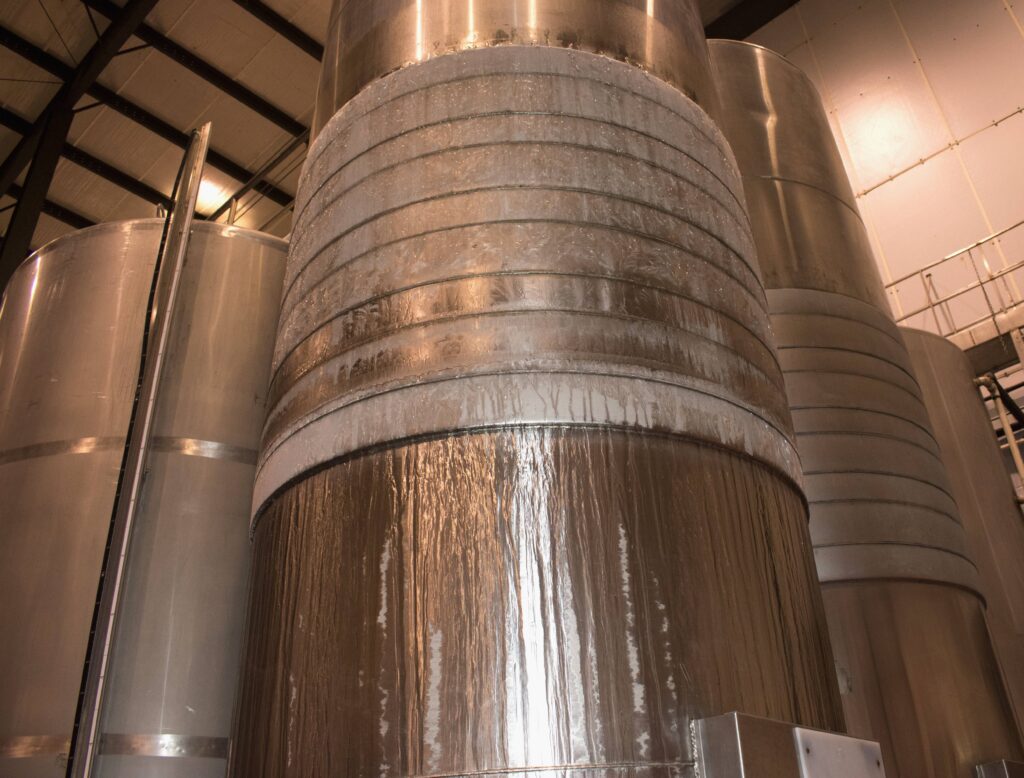By: Gerald Dlubala

A lot of love, time, and work goes into a winemaker’s final product. But there’s also a lot of money and equity tied up in the barrels that hold, age, and nurture that wine. Barrel inspections help protect your product and livelihood by revealing potential leakage areas in the barrel along with any cracks, gaps, or over-toasting, which can directly or indirectly contribute to spoilage, foul aromas, or an undesirable taste in your wine. The stave and head joints should be narrow and tight, with solidly fastened hoops and a tapered bunghole. Bung holes are a common source of spoilage and contamination, and those with cracks emanating from them can be an unwanted source of excessive oxidation.
Storage and Use:
NEW BARRELS
New, empty barrels can be stored indefinitely when regularly maintained and kept in cool, humid conditions to lessen the possibility of shrinkage, preferably in the 55°F (13°C) range with 65-75% humidity. Prepping for storage includes a thorough, clean water rinse and complete drainage before performing a Sulfur purge and bung insertion. In addition, routine checks on Sulfur levels must occur to make sure the levels remain consistent.
Before filling with wine, the stored barrels must be swelled to seal any minor cracks that could cause leaks leading to oxidation and potential mold growth. If Sulfur purging was used in the storage process, release the gas and give the barrel an additional warm water rinse before swelling. Fill the barrel within 20% of its total volume using clean, hot water. Insert the bung and flip and rotate the barrel looking for signs of leakage or agitate the barrel for accelerated swelling until there are no more signs of any leakage. Thoroughly drain the barrel and let it dry and cool down before use. But if leaks are still evident, an overnight swell may be needed, which entails filling the barrel and soaking it overnight. Any leaks should swell shut and stop leaking after a few hours or at the most after a couple of days. Never let a long soak go more than 36 hours without changing the water inside due to the potential for mold growth. When the leaking stops, drain water with the bung side down, and after complete drainage, it is ready for use. If an overnight swelling process doesn’t work, the barrel is likely unfit for use.
Used Barrels Need Different Care
Increasingly, used barrels are only water rinsed before being used for wine storage because the previous contents can be a desired addition to the flavor profile of the wine. Used barrels can also be rinsed several times and stored empty after being purged with Sulfur. Sulfur levels must be checked monthly on the stored barrels and replenished as needed. The stored barrels will shrink over time and need to be swelled again before filling. An alternative to the traditional swelling practices includes filing the barrels with a Sulfur-citric holding solution that promotes sterility and helps promote swelling and shrinkage control. The downside to using a Sulfur citric solution is that it strips the natural wood extract flavor and the desirable oak flavor properties. So it is not recommended for use on new barrels or those less than a year old. The Sulfur citric solution strips natural wood extract flavor. The use of holding solutions requires thorough rinsing procedures before a winemaker can reuse the barrel.
Spoiler Alert
When wood comes in contact with liquids, especially wine, it becomes a natural breeding ground for bacteria and spoilage mechanisms. If your wines have pH levels above 3.7pH combined with low sulfite levels or residual sugar, lactic acid bacteria can cause spoilage and produce a sour milk taste.
Acetobacter (Acetic Acid Bacteria) causes the alcohol in your wine to convert to acetic acid. When combined with the deposits left due to poor rinsing of barrels or lack of or improper Sulfur purging, Acetic acid forms ethyl acetate, the ingredient used in nail polish remover. It frequently happens with wines that oxidize and have headspace, producing the familiar vinegar aroma.
Brettanomyces Yeasts in your barrels mean spoilage. They metabolize very low sugar levels in wine or the cellulose sugars in the wood due to insufficient Sulfur purging of stored barrels or the inadequate presence of sulfites in the barrel. Brettanomyces Yeasts produce an aroma reminiscent of a well-stocked medicine cabinet.
Penicillium mold is one of the most common concerns for winemakers, usually originating through stave or head joints or around the bunghole. Hard to eradicate once it gains a foothold, penicillium mold causes foul aromas when in contact with the wine.
Keep Track and Maintain Consistent Barrel Information
When maintaining and storing your barrels, a system for keeping track and maintenance schedules can be quite helpful, and a winemaker should choose a system based on their specific needs and budget limitations. Limited budgets can make practical use of barcode-based barrel tracking systems that provide inventory and location data for their in-house barrels. If you need more information, like maintenance schedules, barrel history, or tracking information, you may need the benefits of Quick Response (QR) or Radio Frequency Identification (RFID) code technology. Economic factors can lead you to use QR codes for increased data storage with easy read capabilities. However, RFID is a great choice when considering pure efficiency, with passive RFID providing more data storage, faster scanning, and additional location and temperature tracking capabilities over their QR counterparts. With the additional cost of active RFIDs, you can have real-time location data, temperature readings and humidity levels.
Barcode tracking systems are an option that is associated with most if not all things around us. The familiar series of one-dimensional lines constructed of variable thicknesses encode numbers and characters that provide the object’s unique identification number that links back to a database providing all pertinent inventory, maintenance, and barrel information needed for your winery. Barcode labels are economical and easy to read with handheld devices or available smartphone apps. However, the location of the barcode label is critical to correct readability because the barcode label must be within the sight and allowable parameters of the reader.
Quick Response (QR) Codes are the pixelated squares scanned from a smartphone camera to send you to another location or web link. They can be combined with GPS functionality for barrel tracking and store up to a hundred times more information than the basic barcode. If needed, once a barrel is assigned to the database, the winemaker can add more specific barrel information. Unfortunately, paper-printed QR codes are susceptible to humid conditions and durability issues. More durable options increase cost, and if Wi-Fi is needed, that can be an issue in wine cellars.
InnoVint Inc, founded in 2013, is a bud break-to-bottle wine production software company made up of winemakers. Their wine production software optimizes QR codes for wine barrels that are easily scanned on a phone or tablet and allow details on contents, activity, barrel history, and more to be entered. Their QR codes scan well in dirty, wet, or humid conditions and stay with the same vessel for its lifespan while in your cellar, making historical information accessible and easy to retrieve. This information can include things like fill dates or Brix readings for your fermentation tanks. Using InnoVint’s software, the QR codes can be printed or reprinted on demand.
Radio Frequency Identification (RFID) uses radio waves to track objects and their unique data. You won’t need a direct line of sight for this type of tracking, and it scans faster than pointing at a barcode or label. Using Active RFID brings the ability to read from up to 100 feet away with more memory. The RFID tags transmit a continuous signal with real-time statistics. More size and memory bring additional tracking and information functionality, including temperature, humidity levels, and real-time location statistics. But, because they are battery-powered, they are bulky and more costly.
Passive RFID codes, on the other hand, are smaller, more compact, and not reliant on an enclosed battery, making them more economical and longer-lasting than active RFID tags. Passive RFID tags can be inlaid into sticker form or attached like tags, making them more durable and a good fit for wine cellars or barrel storage areas. They are stable under diverse conditions while having the ability to record both interior and exterior temperatures. Passive RFID has more limited data storage capacity but is compatible with real-time location systems for immediate tracking capability. Additionally, available location and temperature data allow variation tracking in temperature versus barrel volume fluctuations and free SO2.
BarrelWise: Enhanced Technology For Wine Production And Analysis
Barrel management is time-consuming and manually labor-intensive, especially for craft wineries. BarrelWise is a project initially conceived and targeted for another industry by a group of University of British Columbia (UBC) students, including Jason Sparrow, now CEO, and Artem Bocharovaz, Director of Sales. By listening to and addressing winemakers’ concerns, they’ve taken their idea and created a system for winemakers that incorporates specialized bungs and a unique hose cart for each wine barrel that allows winemakers to take measurements and top off the barrel with a straightforward action. After successful trials with several wineries fully outfitted with BarrelWise bungs, BarrelWise is building and adding sensing operations to their units.
Smaller wineries can more easily test all of their barrels for free SO2 levels, but Sparrow said that higher producing wineries test as few as five to ten percent simply due to time constraints. In addition, wine barrels routinely have an evaporative loss that may require topping off. With the BarrelWise system, the barrels can stay in place and provide data through their head sensors, allowing winemakers to top off, test, and correct and SO2 levels simultaneously, saving labor and time. By testing every barrel, a winemaker reduces the inherent risk in producing larger batches of wine. Critical decisions are made based on accurate data from each barrel, giving the winemaker more control, confidence, and efficiency in their decision-making. Individual barrels can produce significant variations, and BarrelWise helps the winemaker get each barrel right through easy measurements, accurate data and consistent tracking


















